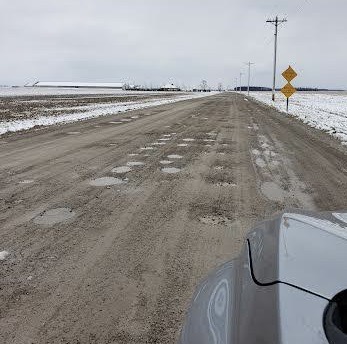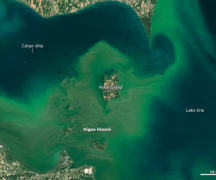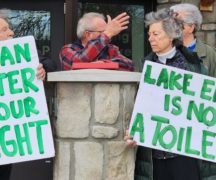By JULIE CARLE
BG Independent News
While a group of local activists await an EPA decision about regulating concentrated animal feeding operations (CAFOs), concerns continue to mount about road and water quality conditions in southern Wood County.
During an October Wood County Democratic Party meeting, Tom Harrison reported that roads are being damaged by trucks and equipment that are used to spread liquid manure from the large dairy farms onto farm fields. He also shared photos of the trucks blocking roads during the manure application, which on at least three occasions impeded routes for Elmwood school buses.
Vickie Askins, who has been speaking out about factory farms in the county for nearly 20 years, confirmed with photos the damage being done to some of the roads near the CAFOs. “Cygnet Road, a half mile east of State Route 235 in front of the Reyskens Dairy is being destroyed by the heavy dairy traffic,” she said.
They have also been known to apply the manure at times that don’t comply with best management practices, she said.
According to Askins, a statewide initiative, known as H2Ohio, has several programs that are good, such as rebuilding wetlands in the state.
“One of the provisions is a $60 per acre payment for applying manure. The idea was to pay landowners to take the manure on fields further away from the CAFO dairies,”
Askins said. “I’ve noticed they are putting it on the same fields they were putting on before, so the payment is not making a difference; they are overloading the same fields.”

(Photo provided by Vickie Askins)
Additionally, some of those fields near the BB Land Dairy (formerly MSB Dairy and Green Dairy) are tiled and adjacent to a branch of the Portage River, meaning some of the manure could be getting into the river that flows into Lake Erie.
“The sad thing is no one is checking any of this. No one is out there making sure they are only putting on so much, and that it is not coming out of the tiles,” Askins said.
The Clean Water Act made it unlawful to discharge any pollutant from a point source into navigable waters unless a permit was obtained, according to the EPA website. A National Pollutant Discharge Elimination System (NPDES) permit limits what can be discharged, monitoring and reporting requirements and other provisions to ensure thatthe discharge does not hurt water quality or people’s health.
In question is a bill passed by the Ohio legislature in 2000 that was to transfer authority for the federal NPDES permits for large farms from the Ohio EPA to the Ohio Department of Agriculture (ODA). During the 20-plus years since then, Askins said no authority was ever granted by the U.S. EPA to transfer that authority to the ODA.
In May 2019, the U.S. EPA Inspector General said a citizens’ petition that had been filed in 2011 could no longer be ignored. The petition claimed the ODA had illegally assumed authority to issue permits for CAFOs above the threshold animal counts in the law, which varies according to the types of animals.
The inspector general’s report indicated the delays impacted federal and state oversight and resulted in regulatory uncertainty of CAFOs in Ohio, Askins said. The corrective actions were due by March 31, 2020, and then COVID-19 happened and further delayed actions.
As she and her fellow guardians optimistically await an announcement about the NPDES permits, they continue to fight for “legitimate manure management plans that contain enough valid fields so that the manure is applied in accordance with agronomic rates,” she said. “Taxpayers should not be forced to prop up this failed model of industrial animal agriculture.”





